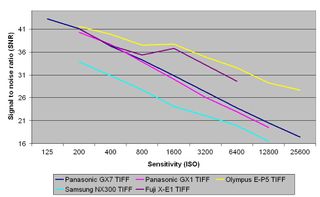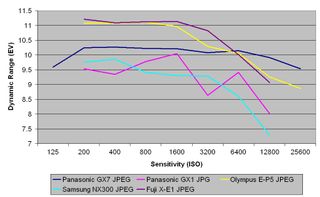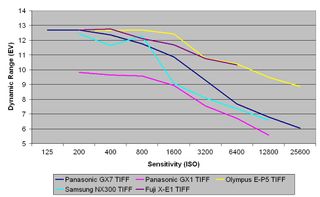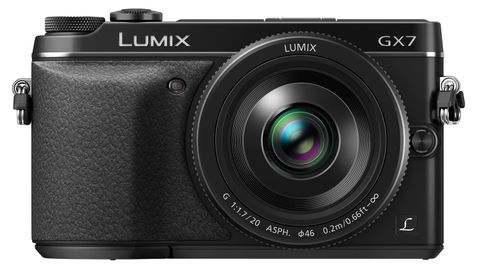Why you can trust TechRadar
We shoot a specially designed chart in carefully controlled conditions and the resulting images are analysed using DXO Analyzer software to generate the data to produce the graphs below.
A high signal to noise ratio (SNR) indicates a cleaner and better quality image.
For more more details on how to interpret our test data, check out our full explanation of our noise and dynamic range tests.
Here we compare the Panasonic Lumix GX7 with the Samsung NX300, Panasonic GX1, Fuji X-E1 and Olympus PEN E-P5. The GX7 has the widest sensitivity range of all the cameras here.
JPEG signal to noise ratio

As we can see from this chart, the Panasonic GX7's JPEG files have a stronger signal to noise ratio than those from the Panasonic GX1 at every sensitivity setting but ISO 400, where the two cameras' images score the same. The GX7's JPEGs are stronger than JPEGs from the Samsung NX300 and Olympus PEN E-P5 at ISO 200-800 and 6400-25600. The GX7's JPEGs have weaker signal to noise ratios than those from the Fuji X-E1 at ISO 800 and above.
Raw signal to noise ratio

The signal to noise ratios of the TIFF images (after conversion from raw) from the Panasonic GX7 are significantly stronger than TIFFs from the Samsung NX300 at every sensitivity setting, and stronger than those from the Panasonic GX1 at every sensitivity setting but ISO 400. The GX7's TIFFs have weaker signal to noise ratios than the Fuji X-E1 and Olympus PEN E-P5, however.
JPEG dynamic range

The Panasonic GX7's JPEGs have stronger dynamic range than JPEGs from the Samsung NX300 and Panasonic GX1 at every sensitivity setting. The GX7's JPEGs have weaker dynamic range than those from the Fuji X-E1 and Olympus PEN E-P5 at ISO 200-3200.
Raw dynamic range

This chart indicates that TIFF images (after conversion from raw) from the Panasonic GX7 contain stronger dynamic range than those from the Panasonic GX1 at every sensitivity setting, and stronger than TIFFs from the Samsung NX300 at every setting but ISO 800. The GX7's TIFFs have weaker dynamic range than those from the Fuji X-E1 and Olympus PEN E-P5 at every sensitivity setting.
Current page: Noise and dynamic range
Prev Page Image quality and resolution Next Page Sample images
